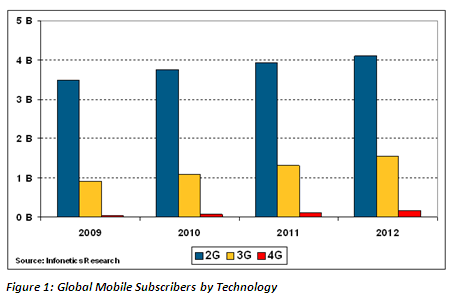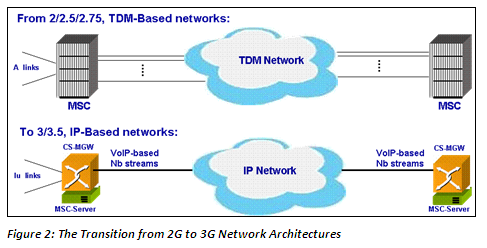infoTECH Feature
November 17, 2009
Insight on India's Telecom Market and Bandwidth Optimization Needs
The State of the Indian Telecom Market
As India’s mobile service providers evolve from 2G to 3G networks, the nation’s rapidly-growing telecom market is poised to require a significant increase in core bandwidth in order to handle voice traffic. After exploring the transition from 2G to 3G and the voice bandwidth requirements of each network, this article will present a next-generation bandwidth optimization solution which can help service providers in India and worldwide cost-effectively embrace this inevitable core network evolution.
The Inevitable Network Evolution
The transition from 2G to 3G and ultimately 4G has begun; however, more than 80% of the world’s mobile subscribers still use 2G service. In India, for example, 3G service is not yet available. Therefore, the number of 2G subscribers in India and globally will continue to grow, surpassing four billion worldwide by 2012 (Figure 1).

With this network evolution on the horizon, service providers are seeking ways to prepare for and ultimately make this transition. One key step involves the core voice network evolution from a network of TDM-based mobile switching systems (MSSs) to an IP-based mobile switching center (MSC (News - Alert)) server (Figure 2).

In 2G networks, voice is carried through the mobile core network between MSC switches uncompressed in 64 Kbps channels. By using compression solutions, mobile operators are able to reduce core bandwidth requirements by a factor of up to 16 with minimal to no reduction in voice quality. In 3G networks, voice arrives from the access network at the mobile media gateway over A-interface or IuCS-interface links, and is then transmitted over the Northbound interface using GSM-AMR or G.711 compression. Moreover, between the media gateways, the voice traffic is carried at a compression ratio of 2.7:1. Therefore, for 2G operators who are used to 8:1 to 16:1 compression ratios, transitioning to 3G networks means a three to five time increase in the bandwidth required to carry the same amount of voice traffic.
Optimizing Bandwidth
To address this problem, service providers need a low cost, scalable solution that can further compress the VoIP sessions sent between the media gateways without degrading voice quality. The requirements for such a solution include but are not limited to: transparency to 3G network elements, support for IP-over-TDM and IP-over-Ethernet networks, and scalability to support small remote sites as well as larger high-capacity nodes. This solution could enable operators to maximize session bandwidth optimization, improve transmission media efficiency, preserve voice quality performance, and offer high service availability. Moreover, this solution would ideally be designed to fit transparently between media gateways, ultimately allowing 3G operators to achieve the same bandwidth reduction benefits they realized when using TDM-based compression solutions between their 2G MSSs.
The Key Takeaway
While 3G and 4G technologies tend to dominate the mobile investment discussion, most mobile subscribers in India and worldwide are still served by 2G networks. As service providers evolve from 2G to 3G, the bandwidth required in the core voice network will increase significantly. Therefore, service providers will require a next-generation VoIP session bandwidth optimization solution which can reduce voice bandwidth in 3G networks and ideally enable them to achieve the same higher bandwidth compression ratios they could achieve utilizing 2G. Mobile operators should investigate solutions from equipment vendors that will enable them to meet these needs.
About the Author
Dawn M. Hogh has served as Vice President of Marketing at Veraz Networks since November of 2007. Prior to joining Veraz, Hogh held executive positions at OpVista (News - Alert), Inc., CIENA Corp, Kestrel Solutions, Lumenaré Networks, and various engineering and marketing leadership roles at Lucent Technologies.
TMCnet publishes expert commentary on various telecommunications, IT, call center, CRM and other technology-related topics. Are you an expert in one of these fields, and interested in having your perspective published on a site that gets several million unique visitors each month? Get in touch.
Edited by Michael Dinan
infoTECH Headlines
What Is AWS EFS? Features, Use Cases, and Critical Best Practices
Cost-Effective Approaches to s1000d Conversion
A virtual crossroads for technology enthusiasts
Benefits of employee monitoring software in preventing overworking of workers
CI/CD: Trends and Predictions for 2024
Technical Documentation for IT: A Practical Guide
Managing Your Costs on AWS: A 2024 Guide
What Is Application Dependency Mapping?
Top 5 Kubernetes Errors and How to Solve Them
How Artificial Intelligence Can Improve the World of Online Gaming Platforms
Vonage Elevates Cloud Communications with Advanced Noise Cancellation and AI Integration
Rich Tehrani
Rich Tehrani
What is a Data Lake
Rich Tehrani
Rich Tehrani



 By
By 
